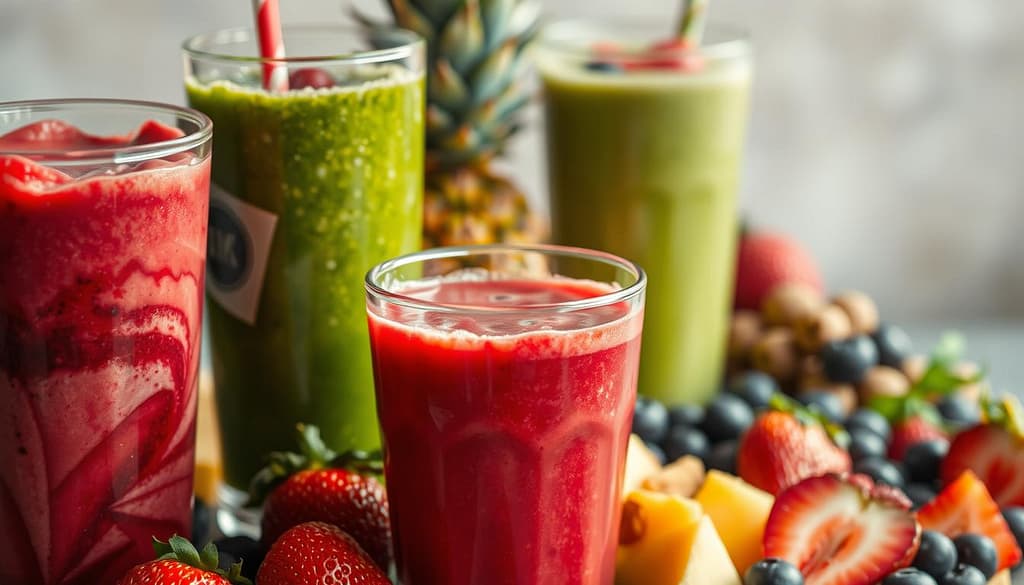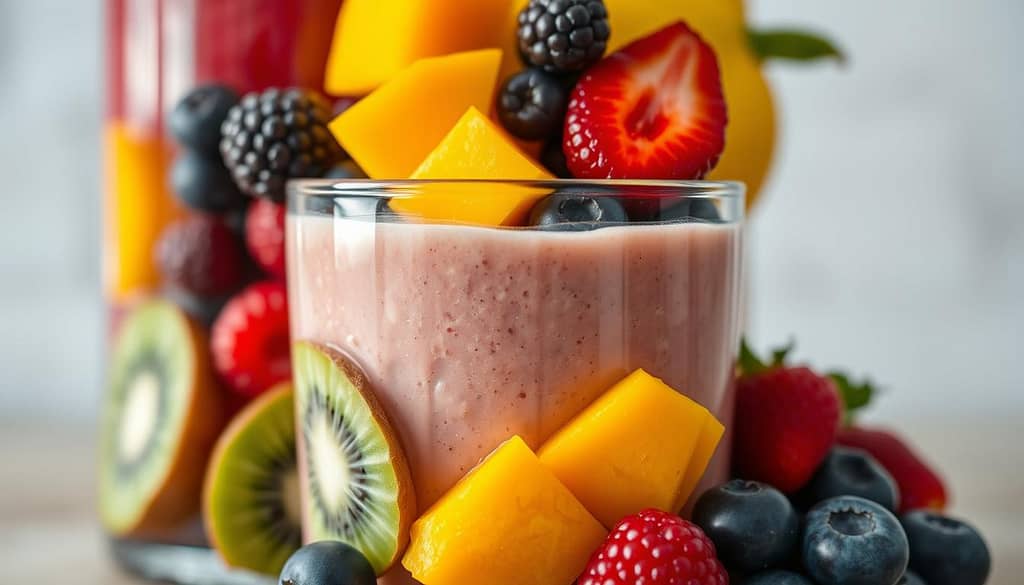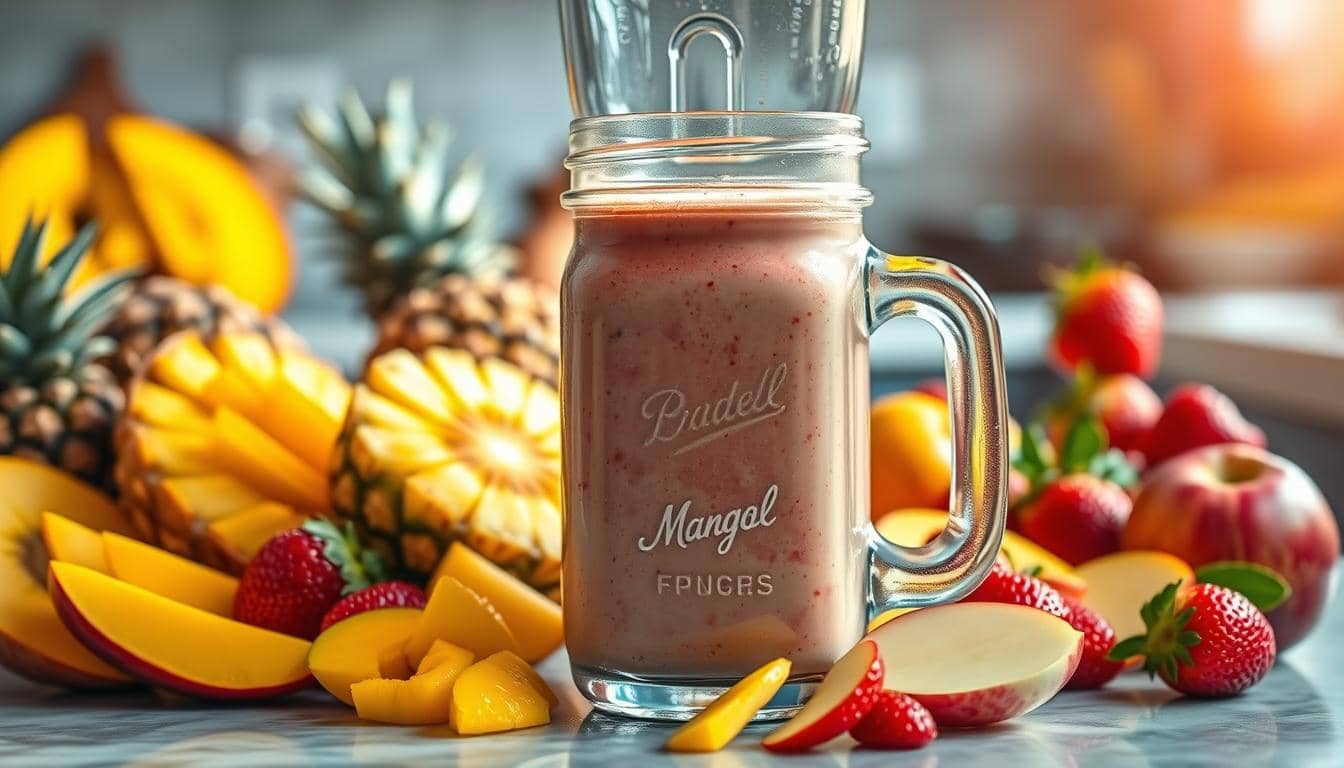Looking for a quick way to boost your nutrition? All-Fruit Smoothies are here to help. These delicious fruit smoothies mix vitamins, fiber, and natural sweetness without added sugars. Andrea Mathis, M.A., R.D.N., L.D., says they’re perfect for a nutrient-packed start to your day.
Whether you sip them for breakfast or a snack, they’re a refreshing way to fuel your body with real ingredients.
Why choose all-fruit smoothies? Frozen fruit makes them easy—no prep needed. Brands like Daily Harvest offer 30+ flavors, using produce frozen at peak ripeness to lock in nutrients. No additives, no dairy, and no compromises on taste.
Plus, frozen fruit is budget-friendly and adds creaminess, making every blend satisfying.
Key Takeaways
- Delicious fruit smoothies blends count as 1–2 daily fruit servings.
- Frozen fruit locks in nutrients and cuts costs compared to fresh options.
- Most blends average 221 calories with 7g protein per serving.
- Daily Harvest uses sustainably sourced ingredients without added sugars.
- All-Fruit Smoothies offer vitamins, fiber, and natural antioxidants in every sip.
The Rising Popularity of All-Fruit Smoothies

All-Fruit Smoothies are changing how we snack. They’re part of a clean-eating trend that focuses on whole fruits and natural tastes. With 43% of Americans snacking every day, these smoothies are perfect for busy lives without added sugars.
Why Fruit-Only Blends Are Trending
There are three main reasons for this trend:
- Clean ingredients: No hidden syrups or additives.
- Functional benefits: Antioxidant-rich acai and pomegranate are key in healthy smoothie recipes.
- Convenience: Meal-prepped blends save time. Jamba’s new Acai Peanut Butter smoothie shows even big chains want nutrient-dense options.
The Difference Between Smoothies and Juices
| Smoothies | Juices |
|---|---|
| Pack in fiber, pulp, and whole vitamins | Strain out fiber for liquid-only drinks |
| More filling (keeps hunger at bay) | Quick sugar spike, less satiation |
| Price: $12.77/L (market data) | Price: $4.98L (market data) |
The Smoothie Revolution in American Diets
“Functional foods like protein-rich Smoothie King blends are replacing soda and chips as everyday snacks.”
Today, smoothies are more than just breakfast. They’re full meals. The $664M market is growing 6.06% each year, as people choose refreshing fruit smoothie combinations over sugary drinks. Even fast-food chains like Jamba are now focusing on meal-replacement options.
With options like CBD-infused and nut-free smoothies, there’s something for everyone. Next time you’re looking for a snack, consider this: Why choose a soda when your blender can make something better?
Health Benefits That Come in Every Sip
All-Fruit Smoothies are more than a cool drink—they’re packed with nutrients. Only 1 in 10 Americans eat enough fruits and veggies. A smoothie can give you 2–3 servings of fruit, helping you meet your daily needs.
With healthy smoothie recipes like berry or tropical mixes, you get vitamins and antioxidants. You get vitamin C from citrus and antioxidants from dark greens. All while enjoying a convenient drink.

- Immune boost: Citrus fruits and berries deliver vitamin C to support immunity.
- Digestive health: Natural fiber in whole fruits aids digestion and keeps you full longer.
- Sustained energy: Unlike sugary snacks, whole-fruit blends provide slow-burning energy without crashes.
“Diverse plant consumption improves gut microbiome diversity,” noted a 2018 study in mSystems. Adding berries, mangoes, or kiwi boosts your intake of 30+ plant types weekly—key for a thriving gut.
Whole fruits keep fiber that slows sugar absorption. A 2020 study showed raspberry-passionfruit combinations caused smaller blood sugar spikes than juices. Pair fruits with spinach or avocado for healthy fats and fiber. Even a quarter avocado adds potassium and creaminess without excess sugar.
Pro tip: Blend frozen fruit for creaminess instead of sugary syrups. Tasty all-fruit smoothie options like banana-blueberry or pineapple-coconut can fit into portion-controlled diets. Just remember—keep added sugars in check by avoiding pre-made mixes loaded with syrup. Your body gets more nutrients from whole produce than juices, so stick to recipes using whole ingredients.
Essential Nutrients Found in All-Fruit Smoothies
Every sip of delicious fruit smoothies gives you vitamins, fiber, and antioxidants. These drinks are not just yummy; they also give you energy for the day. Let’s explore what makes them so good for you.
Vitamins and Minerals You’re Getting
Bananas are full of potassium, berries are packed with vitamin C, and mangoes have vitamin A. Spinach or kale add folate and iron. Juice Press’s healthy smoothie recipes like Blue Magic have 23g protein and 65 nutrients.
| Product | Protein (g) | Key Nutrients |
|---|---|---|
| Strawberry Banana Kit | 19 | Potassium, fiber |
| Clean Green | 15 | Antioxidants, vitamins |
| Blue Magic | 23 | Omega-3s, choline |
Natural Antioxidants and Their Benefits
“Berries and citrus are antioxidant powerhouses,” says the American Heart Association, highlighting their role in fighting inflammation.
Antioxidants in delicious fruit smoothies like acai or pomegranate protect cells. They help fight heart disease and aging.
Fiber Content and Digestive Health
Fiber in whole fruits slows down sugar absorption. A half-cup of avocado adds healthy fats and fiber. Blending keeps fiber in, unlike juicing, making your gut happy!
Natural Sugars vs. Added Sugars
- Natural sugars come with fiber and nutrients.
- Added sugars spike blood sugar and lack vitamins.
Choose healthy smoothie recipes like blueberries + Greek yogurt for balanced nutrition.
Best Fruits to Include in Your Smoothie Blends
Choosing the right best fruit smoothie ingredients makes your smoothies super healthy. Berries are like nature’s superfoods. Blueberries, strawberries, and raspberries add sweetness without too much sugar. They’re perfect all year, thanks to frozen options.
- Berries: Add a handful of strawberries or blueberries for vitamin C and anthocyanins. Try blending with spinach and mango for a 200-calorie combo under 10 minutes.
- Tropical flavors: Pineapple and mango deliver vitamin C and fiber. Mix with almond milk and a banana for creaminess—like Prevention’s recipe using frozen peaches and bananas.
- Stone fruits: Peaches and plums shine in summer blends. Pair with yogurt and a dash of honey for a delicious fruit smoothies that’s ready in 5 minutes.
For fruit-based smoothie ideas, try Revive Superfoods’ pre-portioned packs or create your own combos. Blend dragon fruit with raspberries for iron-rich tropical treats or pair cherries with cacao for a chocolatey kick. Always balance flavors: tangy citrus with creamy avocado, or sweet mango with zesty lime.
Remember, frozen fruit works magic. Use 1 cup fresh to 2 cups frozen for texture. Add spinach or matcha for greens without altering taste. Experiment weekly—your taste buds (and body) will thank you!
Seasonal Smoothie Guide: What to Blend Year-Round
Discover fruit-based smoothie ideas that match the seasons. Fruits taste sweeter and are cheaper when they’re in season. Here’s your guide to refreshing fruit smoothie combinations for every month:
| Season | Peak Fruits | Example Combinations |
|---|---|---|
| Winter | Oranges, grapefruit, pomegranate | Orange + kale + frozen berries + almond milk |
| Spring | Strawberries, rhubarb, early cherries | Strawberry + rhubarb + Greek yogurt + mint |
| Summer | Melons, peaches, berries | Watermelon + mint + lime + yogurt |
| Fall | Apples, pears, persimmons | Apple + pear + cinnamon + almond butter |
Make All-Fruit Smoothies to save money and enjoy the best flavors. Mix seasonal fruits with frozen ones (like berries in winter) for a good balance. Try our fruit-based smoothie ideas library, like the Clementine Avocado or Pumpkin Pie Smoothie recipes.
Pro tip: Keep frozen mango or banana on hand for texture all year. Visit local farmers’ markets to find out what’s in season. Use ripe fruits to sweeten your smoothies instead of adding sugar.
Creating the Perfect Texture for Your All-Fruit Smoothies
Perfect texture makes ordinary blends into delicious fruit smoothies. Too thick, thin, or gritty? These homemade fruit smoothie tips fix common problems quickly. Start with the right ratios and techniques for silky results every time.
The Importance of Fruit-to Liquid Ratios
Start with 1.5 cups of fruit and 1 cup of liquid. Frozen bananas or mangoes are great bases for easy fruit smoothie blends. Add more liquid for thinner sips or extra fruit for thickness. Most blenders need at least 2 cups total to blend smoothly.
Blending Techniques for Optimal Consistency
- Layer liquids first, then soft fruits like berries, then harder items like pineapple.
- Pulse ingredients 10 seconds to break down chunks before blending continuously.
- Use high speed for 30-60 seconds until velvety.
Using Frozen vs. Fresh Fruits
60% of smoothie lovers use frozen fruits for creaminess. Freeze bananas or berries in 1-cup portions for quick prep. For easy fruit smoothie blends, mix 2 parts frozen with 1 part fresh for balance. Avoid ice cubes—they water down flavor.
Mastering these tricks ensures every sip is smooth, not slushy or gritty. Adjust ratios and freezing to suit your taste, and you’ll never guess these delicious fruit smoothies are packed with vitamins!
Quick and Easy Fruit Smoothie Recipes to Try Today
Need a quick breakfast or snack? These easy fruit smoothie blends are ready in under five minutes. They’re perfect for busy mornings. Each recipe uses just fruit and optional yogurt or juice for creaminess. You can customize ingredients based on what’s in your pantry—your taste buds will thank you.
Berry Blast
Combine 1 cup mixed berries (strawberries, blueberries, raspberries) with ½ cup orange juice and a handful of ice cubes. Blend until smooth. Add a splash of coconut water for extra electrolytes. This tasty all-fruit smoothie option packs 5g fiber and 12g natural sugar.
Tropical Paradise
Mix 1 ripe mango, ½ cup pineapple, ½ banana, and 1 tsp lime juice. Blend with ½ cup coconut water. For creaminess, add ¼ cup frozen yogurt. This healthy smoothie recipe delivers 289 kcal and 6g protein per serving.
Citrus Sunrise
Blend 2 oranges, ½ grapefruit, and 1 kiwi with 1 cup sparkling water. No sugar needed—the citrusy tang is naturally bright. Store leftovers in a sealed jar for up to 12 hours.
Pro tip: Freeze overripe fruit in ziplock bags for future batches. Add chia seeds or spinach to boost nutrition without altering taste. Experiment with ratios—like 1 cup pineapple to ½ cup mango—for your perfect balance. These easy fruit smoothie blends are your shortcut to balanced nutrition without sacrificing flavor.
How to Meal Prep Smoothie Ingredients
Learn homemade fruit smoothie tips to save time and keep flavors fresh. Meal prepping makes All-Fruit Smoothies easy to grab on busy mornings. Begin by preparing ingredients in large batches to simplify your morning routine.
- Freeze berries whole in a single layer on a baking sheet before transferring to airtight containers.
- Slice bananas and mangoes before freezing to avoid clumping.
- Label containers with dates to track freshness.
Pre-Made Packs for Speed:
Use reusable bags or mason jars to portion fruits for easy fruit smoothie blends. Mix 1 cup of mixed berries with sliced bananas for a quick morning smoothie. Add a ¼-cup yogurt portion to each pack for creaminess.
Storage Secrets for Freshness:
Freeze prepped ingredients for up to 3 months. Store fridge-stored blends in glass jars with ½ inch headspace for expansion. Use within 48 hours for the best taste.
Pro tip: Spend 1 hour weekly chopping, freezing, and packing ingredients. This reduces morning prep time to under 5 minutes. Pair with overnight oats or yogurt for a complete breakfast!
Equipment Essentials for Homemade Fruit Smoothies
Choosing the right tools is key for homemade fruit smoothie tips. A strong blender is essential. Look for models like the Vitamix A3500 (1,640W) or Breville Fresh & Furious (1,100W) for smooth purees. Even the NutriBullet Pro 900 (600W) is great for All-Fruit Smoothies, as shown in 120+ blender tests.
- Blending power: Higher wattage handles fibrous fruits like pineapple or mango.
- Capacity: 32-64 oz jars suit single servings or family batches.
- Extras: Pre-measured cups, reusable straws, and fruit peelers streamline prep.
Use mason jars to store tasty all-fruit smoothie options for up to 24 hours. Clean blades often to avoid dullness. For the best texture, add liquid first, then ice, and lastly frozen fruit. Even basic blenders can make great smoothies with the right techniques.
Invest in a produce wash for non-organic fruits. Tools like corers or zesters can save time. Remember, the best All-Fruit Smoothies come from fresh ingredients and proper technique. Your kitchen doesn’t need to be fancy—just efficient!
Common Mistakes to Avoid When Making Fruit Smoothies
Learning to make great fruit smoothies means avoiding common mistakes. Even small errors can make your smoothie lumpy or unbalanced.
Overloading Your Blender
Don’t overfill your blender! Too much can damage the motor and leave chunks. Here’s a simple guide:
| Blender Size | Max Fruit Volume |
|---|---|
| Small (500ml) | 2 cups frozen fruit + 1 cup liquid |
| Large (1L) | 4 cups frozen + 2 cups liquid |
If you need to, blend in batches. Your blender will appreciate it.
Poor Ingredient Layering
For a smooth blend, layer your ingredients like this:
- Liquid base (coconut water, almond milk)
- Soft fruits (bananas, avocados)
- Frozen fruits last (berries, mango chunks)
Tip: Add spinach or other greens after the liquid to avoid clumps.
Missing the Balance of Flavors
Balance sweet and tart flavors to avoid a one-dimensional taste. Try these:
- Strawberries + lime juice
- Peaches + a hint of vanilla bean
- Banana + dark chocolate cacao nibs
Keep it simple with 3-4 main ingredients to avoid flavor clashes.
Even experts make mistakes. But with practice, you’ll get it right. Follow these best fruit smoothie ingredients tips for a perfect smoothie.
Refreshing All-Fruit Smoothie Combinations for Every Palate
Try out refreshing fruit smoothie combinations to find your favorite flavors. Whether you like sweet, tart, or bold tastes, there’s something for you. Here are some great pairings to start with:
- Sweet Lovers: Mango-pineapple-banana makes a creamy tropical mix. Add vanilla extract for extra flavor.
- Tart Enthuasiasts: Combine mixed berries with green apple for a zesty taste. Add a squeeze of lime for more zing.
- Refresher Fans: Watermelon-melon-lime is great for summer. Freeze the fruit for a cold treat.
- Adventurous Tasters: Strawberry-basil or peach-lavender add unique twists. Start with 1-2 basil leaves for a hint of flavor.
Keep flavors balanced by using a 1:1 fruit-to-liquid ratio. For a thicker smoothie, use frozen fruit. Brands like Revive Superfoods have fruit-based smoothie ideas for quick meals. Remember, there’s no wrong combination—let your taste guide you!
“This delicious bright green smoothie bowl with spinach and mango contains 10 essential nutrients, under 200 calories,” says a recent study. Top with cucumber slices for extra hydration.
Blend dragon fruit with raspberries for a vitamin C-rich smoothie. Add chia seeds for extra fiber. Swap 1 cup of fruit with frozen pineapple for a cool texture. The secret is to experiment until you find your ideal mix.
Transforming Your Smoothie into a Complete Meal
Make your healthy smoothie recipes into full meals by adding the right ingredients. Try adding avocado, chia seeds, or nut butter. They increase protein and healthy fats while keeping your smoothie fruity.
- Avocado: Adds creamy texture and heart-healthy fats.
- Chia Seeds: Mix 1 tbsp into your blend for fiber and omega-3s.
- Nut Butter: A small spoonful thickens and adds plant-based protein.
- Leafy Greens: Spinach or kale boost iron and vitamins without overwhelming fruit flavors.
| Recipe | Ingredients | Nutritional Boost |
|---|---|---|
| Complete Breakfast Blend | 1 banana, ½ avocado, ½ cup berries, 1 tbsp chia seeds | 12g protein, 10g fiber, healthy fats |
| Daily Harvest Avocado + Greens | Frozen avocado, spinach, mango, almond milk | 8g protein, 7g fiber, probiotics from yogurt add-on |
| Mango-Ginger Power | 16 oz frozen mango, 1 cup water, ½ tsp ginger, 1 tbsp flaxseed | Anti-inflammatory benefits + 6g fiber |
Enjoy your smoothie with almonds or whole-grain toast for more energy. Adding 1 tbsp of wheat germ increases fiber without changing the taste. Try different combinations to find your favorite!
Conclusion: Embracing the All-Fruit Smoothie Lifestyle
Adding delicious fruit smoothies to your routine is more than a drink—it’s a step toward better health. All-Fruit Smoothies offer vitamins, fiber, and natural sweetness without added sugars. This makes them a smart choice. Think of a medium apple’s 4 grams of fiber or its heart-healthy benefits.
When you make smoothies at home, you control what goes in them. Unlike store-bought versions packed with extra sugar, your homemade blend ensures quality. Start small: swap one snack a week with a healthy smoothie recipe. Mix berries, tropical fruits, or stone fruits for flavor and nutrition.
Remember, even small changes matter. The Nourish Method highlights how balanced meals support long-term health. Each smoothie can contribute to daily goals, like 2 fruit servings or fiber intake. Gradually, this habit builds into a lifestyle that values whole foods and mindful eating.
So why wait? Blend a quick treat today. Whether it’s breakfast on the go or a post-workout boost, All-Fruit Smoothies prove that eating well doesn’t have to be complicated. Your body—and taste buds—will thank you.

